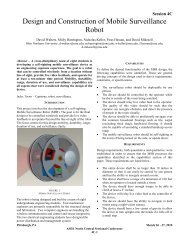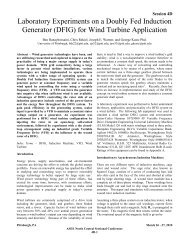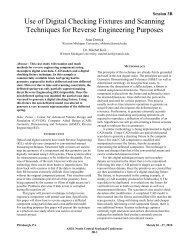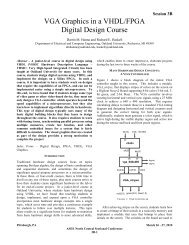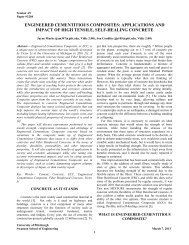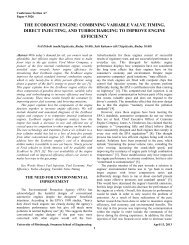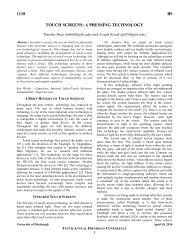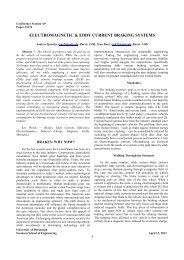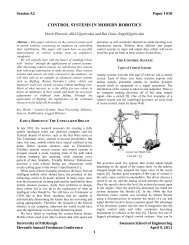economic analysis of additive manufacturing for final products
economic analysis of additive manufacturing for final products
economic analysis of additive manufacturing for final products
Create successful ePaper yourself
Turn your PDF publications into a flip-book with our unique Google optimized e-Paper software.
Garrett White<br />
Daniel Lynskey<br />
Impacts on environmental sustainability<br />
One <strong>of</strong> the main focuses <strong>of</strong> the sustainable movement<br />
today is on the environment. Above all, sustainability<br />
focuses on preserving a healthy environment that will allow<br />
human life to continue flourishing. Attempting to create<br />
such an environment while also developing new<br />
technologies involves the reduction <strong>of</strong> energy consumption,<br />
and material consumption. AM machines have the potential<br />
to reduce the amount <strong>of</strong> energy used in the <strong>manufacturing</strong><br />
process. First <strong>of</strong> all, as previously mentioned, having a rapid<br />
<strong>manufacturing</strong> machine on site eliminates the need <strong>for</strong><br />
transportation, there<strong>for</strong>e greatly reducing the amount <strong>of</strong> fuel<br />
used. Even if the AM machine cannot be located on site, if<br />
it is being used to produce light weight <strong>products</strong> it will be<br />
significantly more energy efficient to transport the items<br />
because “lighter structures require less energy to move”<br />
[12]. The United States Department <strong>of</strong> Energy, “anticipates<br />
that <strong>additive</strong> processes would be able to save more than 50%<br />
energy use compared to today’s ‘subtractive’ <strong>manufacturing</strong><br />
processes” [13]. It is also stated that typical subtractive<br />
methods such as CNC (computer numerical control) milling<br />
<strong>of</strong>ten find scrap rates as high as 95% when milling from a<br />
block <strong>of</strong> existing material [14]. This number can be<br />
significantly reduced by the bottom up approach <strong>of</strong> AM. The<br />
goal <strong>of</strong> product redesign <strong>for</strong> AM is to recreate <strong>products</strong> in<br />
the most efficient ways possible. This can be done by<br />
utilizing AM abilities to create complex interior structures<br />
and reducing the amount <strong>of</strong> waste in the process. Since,<br />
ultimately, less material is used, AM can prove to be very<br />
cost effective.<br />
Impacts on social sustainability<br />
The social dimension <strong>of</strong> sustainability involves<br />
improving the quality <strong>of</strong> life <strong>of</strong> humans, through healthrelated<br />
advancements, increased consumer satisfaction, and<br />
financial improvement. Additive <strong>manufacturing</strong> poses the<br />
ability to make changes to each <strong>of</strong> these realms. First, in<br />
health-related fields, AM shows perhaps even more promise<br />
than one would immediately think. Although not discussed<br />
at length previously in this paper, AM does possess unique<br />
capabilities to produce very high quality devices <strong>for</strong> human<br />
health improvement. In the Bioengineering field, AM is<br />
currently being researched as a possible means to create very<br />
high quality scaffolds, <strong>for</strong> skin and organ regeneration.<br />
Scaffolding requires very precise structure, which AM can<br />
produce unlike any other <strong>manufacturing</strong> process be<strong>for</strong>e. On<br />
top <strong>of</strong> this, AM is also being used <strong>for</strong> custom-fit prosthetics,<br />
because <strong>of</strong> its ability to create unique <strong>products</strong>. Along with<br />
prosthetics, other medical devices, such as custom-fit<br />
hearing aids, orthopedic implants, and dental braces [3].<br />
Beyond medical advances, AM also provides the ability to<br />
greatly change customer satisfaction. As previously<br />
mentioned, “consumers are becoming increasingly refined in<br />
their tastes and desires <strong>for</strong> new <strong>products</strong>” [7]. AM processes<br />
make mass customization viable, which would obviously<br />
greatly impact a customer’s sense <strong>of</strong> satisfaction. Most<br />
consumers typically enjoy individualized <strong>products</strong> that are<br />
geared towards their own desires. Since AM machines<br />
require only a 3D digital model <strong>of</strong> the product to create it, it<br />
is even possible <strong>for</strong> consumers to become their own<br />
designers. This is a vast concept that would revolutionize<br />
consumer satisfaction. Increased customer satisfaction not<br />
only benefits consumers, but also benefits the producers,<br />
because <strong>of</strong> potential increase in sales. Increase in sales is<br />
something that all producers are currently striving <strong>for</strong>, in an<br />
attempt to stabilize the American economy.<br />
Impacts on <strong>economic</strong> sustainability<br />
Sustainable <strong>economic</strong>s are yet another focus <strong>of</strong> the<br />
sustainability motion, and nearly all other aspects <strong>of</strong><br />
sustainability can be indirectly connected to <strong>economic</strong>s, as<br />
well. The <strong>economic</strong> dimension <strong>of</strong> sustainability involves<br />
present actions that will allow <strong>for</strong> future generations to enjoy<br />
equal or greater wealth, welfare, and consumption abilities.<br />
AM is perhaps most disruptive here, because <strong>of</strong> its ability to<br />
revolutionize <strong>manufacturing</strong> <strong>economic</strong>s. Each <strong>of</strong> the topics<br />
previously mentioned in this paper discuss some <strong>of</strong> the<br />
<strong>economic</strong> changes AM brings about. These changes would<br />
be effective <strong>for</strong> the long-run <strong>of</strong> the <strong>manufacturing</strong> paradigm<br />
we see today. As far as wealth preservation is concerned,<br />
AM also shows the ability to greatly change overall cost <strong>of</strong><br />
production.<br />
COST ANALYSIS OF ADDITIVE<br />
MANUFACTURING<br />
The previous sections in this paper focus on effects that<br />
<strong>additive</strong> <strong>manufacturing</strong> <strong>of</strong> end-usable parts could bring to<br />
the economy <strong>of</strong> an industry. Each <strong>of</strong> these topics has been<br />
related to the production and distribution <strong>of</strong> parts, but they<br />
each also have connection to the actual cost <strong>of</strong> production.<br />
For example, using mass customization techniques in AM<br />
production leads to a higher rate <strong>of</strong> customer satisfaction [7].<br />
Although customer satisfaction does not affect the cost <strong>of</strong><br />
production <strong>of</strong> each part, it does lead to more purchases,<br />
which obviously leads to more revenue <strong>for</strong> the producer.<br />
This revenue then allows the manufacturer to pay <strong>for</strong> the<br />
costs <strong>of</strong> production. Next, lightweight parts created with the<br />
use <strong>of</strong> product redesign make an obvious <strong>economic</strong> impact.<br />
In particular application to the aircraft industry, a lower<br />
massed part can lead to astronomical differences in fuel<br />
consumption, and there<strong>for</strong>e cost. A consortium based in<br />
Germany and consisting <strong>of</strong> Laser Zentrum Nord (LZN)<br />
GmbH, the Institute <strong>of</strong> Laser and System Technologies<br />
(iLAS) <strong>of</strong> Hamburg University <strong>of</strong> Technology, and Airbus<br />
Operations GmbH, has shown, “Eliminating 100 kg (220<br />
lbs) is said to save an airline $2.5 million annually in fuel<br />
costs <strong>for</strong> short haul flights” [14]. Along with this reduction<br />
5




